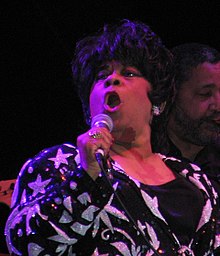Portal:Rhythm and blues
Introduction

Rhythm and blues, frequently abbreviated as R&B or R'n'B, is a genre of popular music that originated within African-American communities in the 1940s. The term was originally used by record companies to describe recordings marketed predominantly to African Americans, at a time when "rocking, jazz based music ... [with a] heavy, insistent beat" was becoming more popular. In the commercial rhythm and blues music typical of the 1950s through the 1970s, the bands usually consisted of a piano, one or two guitars, bass, drums, one or more saxophones, and sometimes background vocalists. R&B lyrical themes often encapsulate the African-American history and experience of pain and the quest for freedom and joy, as well as triumphs and failures in terms of societal racism, oppression, relationships, economics, and aspirations.
The term "rhythm and blues" has undergone a number of shifts in meaning. In the early 1950s, it was frequently applied to blues records. Starting in the mid-1950s, after this style of music had contributed to the development of rock and roll, the term "R&B" became used in a wider context. It referred to music styles that developed from and incorporated electric blues, as well as gospel and soul music. From 1960s to 70s, some British groups were referred to and promoted as being R&B bands. By the 1970s, the term "rhythm and blues" had changed once again and was used as a blanket term for soul and funk. (Full article...)
Selected article
"We Belong Together" is a pop/R&B song recorded by Mariah Carey for her tenth studio album The Emancipation of Mimi (2005) and released as the album's second single in 2005. Written and produced by Carey, Jermaine Dupri, Manuel Seal, and Johnta Austin, the song was inspired by 1980s R&B and soul. Its arrangement is built on simple piano chords and an understated back beat, and its lyrics chronicle a woman's desperation for her former lover to return after their separation.
Following a career-decline between 2001 and 2003, Carey achieved considerable success with "We Belong Together" as the song topped the charts in many countries, including Australia, Brazil, Croatia, Philippines, South Africa, and the United States Billboard Hot 100 for fourteen non-consecutive weeks. The song is also the most successful song by a female artist in the history of Billboard.
In the U.S., the song also repeatedly broke many BDS Airplay records. The song was warmly received by critics, and won Carey a number of industry awards, including two Grammy Awards in 2006.
Further information: The Emancipation of Mimi
"We Belong Together" was not composed until late into the production of The Emancipation of Mimi.[2] Following an unsuccessful career period between 2001 and 2003, Carey began production on the album in 2004. By November of that year she had considered the album complete, but some of what became its more popular tracks had yet to be written.[2] Antonio "L.A." Reid, the chairman of Island Def Jam Records, encouraged Carey to attempt additional studio sessions with producer Jermaine Dupri. "L.A. was like, 'You and Jermaine Dupri make magic together, why aren't you in the studio with him?'" she recalled. "'I said, 'I love Jermaine, is he free? I know he's doing a million things.' [...] But Jermaine said, 'Come on down.'"[2]
Topics
Featured Articles

Featured articles: "Baby Boy" · "Déjà Vu" · "Halo" · "Irreplaceable" · Janet Jackson · Michael Jackson · Mariah Carey · Sly & the Family Stone · Sons of Soul · The Supremes · Thriller · The Way I See It
Good articles: Afrodisiac · "Burn" · "Caught Up" · Christina Milian · Confessions · "Forgive Me" · FutureSex/LoveSounds · "Get Me Bodied" · "Green Light" · House of Music ·I Want You · LeToya Luckett · Let's Get It On · "Lose My Breath" · Maxwell's Urban Hang Suite · Modern Sounds in Country and Western Music · "My Boo" · My World · "Naughty Girl" · Nina Simone · Off the Wall · "Ring the Alarm" · Soul Food Taqueria · There's a Riot Goin' On · "Untitled (How Does It Feel)"· Voodoo · "We Belong Together" · "What Goes Around.../...Comes Around" · Winter in America · "Yeah!"
WikiProjects
Selected biography -
Jean-Baptiste Illinois Jacquet (October 30, 1922 – July 22, 2004) was an American jazz tenor saxophonist, best remembered for his solo on "Flying Home", critically recognized as the first R&B saxophone solo.
Although he was a pioneer of the honking tenor saxophone that became a regular feature of jazz playing and a hallmark of early rock and roll, Jacquet was a skilled and melodic improviser, both on up-tempo tunes and ballads. He doubled on the bassoon, one of only a few jazz musicians to use the instrument. (Full article...)General images -
Related portals
Subcategories
Associated Wikimedia
The following Wikimedia Foundation sister projects provide more on this subject:
-
Commons
Free media repository -
Wikibooks
Free textbooks and manuals -
Wikidata
Free knowledge base -
Wikinews
Free-content news -
Wikiquote
Collection of quotations -
Wikisource
Free-content library -
Wikiversity
Free learning tools -
Wiktionary
Dictionary and thesaurus
Things to do
|
















































